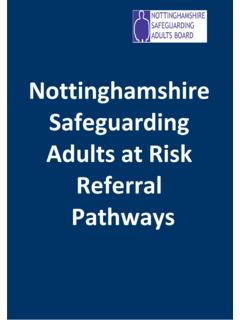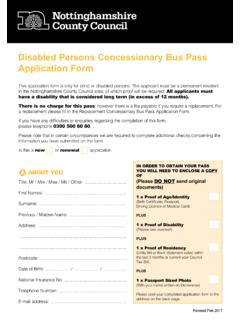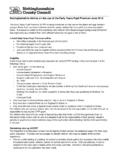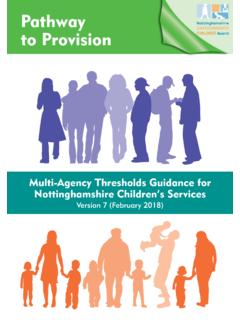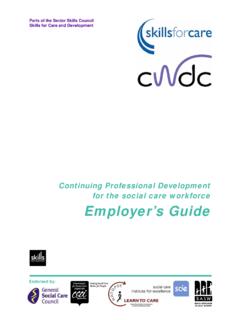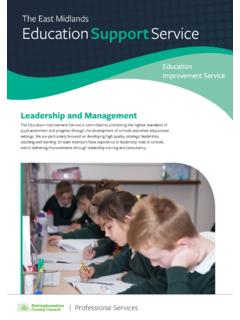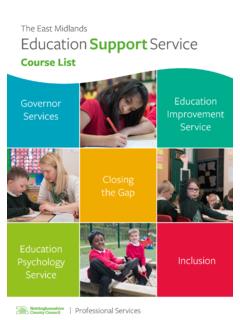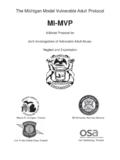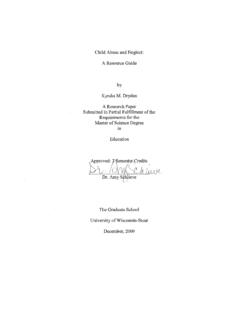Transcription of Nottingham and Nottinghamshire Multi Agency Adult ...
1 Nottingham and Nottinghamshire Multi Agency Adult safeguarding Procedure for Raising a Concern and Referring Version number: Approved with effect from: 18/1/2017 Previous version: 01/08/2016. Amendments: To reflect changes to Nottingham City Council Health and Care Point helpline Contents 1. Introduction .. 3. 2. Definitions used in this Procedure .. 4. Adult at risk .. 4. Personal Budgets and Self Directed Support .. 5. Those who fund their own care arrangements .. 5. 3. Abuse and neglect .. 5. Links to other processes and procedures .. 5. Children who allegedly abuse .. 6. Historical abuse .. 6. 4. Self harm .. 6. 5. Terminology and symbols .. 6. 6. Guidance .. 6. 7. Timescales .. 7. 8. Flowchart for raising a concern' .. 8. 9. Raising a concern about abuse or neglect .. 9. All staff .. 9. Members of Public .. 9. Whistleblowing' .. 9. Staff who suspect abuse in other organisations .. 10. Staff who have concerns about the quality of care in other organisations .. 10. 10.
2 Being told about or raising a concern about abuse or neglect .. 10. Taking immediate action .. 10. Responding to concerns raised directly with you .. 11. Record keeping .. 11. 11. Flowchart for referring' .. 11. 12. Role of referrer .. 13. Who is the referrer? .. 13. Rampton Hospital referrals .. 13. Immediate safety and 14. Information gathering .. 14. Deciding whether or not to make a referral .. 15. 13. Making a referral to the relevant local authority .. 16. Getting the consent of the Adult at risk .. 16. Making a decision to refer without consent .. 16. Outcomes for the Adult at risk .. 17. Record keeping .. 17. Information you will need to make the referral .. 17. Where to make the referral .. 18. Making a referral out of hours .. 19. Making a decision NOT to make a referral .. 19. 14. Local authority response .. 19. Section 42 19. Investigations .. 20. Outcomes .. 20. Review .. 21. Feedback .. 21. 15. 21. 2. 1. Introduction safeguarding means protecting an Adult 's right to live in safety, free from abuse and neglect.
3 It is about people and organisations working together to prevent and stop both the risks and experience of abuse or neglect, while at the same time making sure that the Adult 's wellbeing is promoted including, where appropriate, having regard to their views, wishes, feelings and beliefs in deciding on any action. The aims of Adult safeguarding are to: stop abuse or neglect wherever possible;. prevent harm and reduce the risk of abuse or neglect to adults with care and support needs;. safeguard adults in a way that supports them in making choices and having control about how they want to live;. promote an approach that concentrates on improving life for the adults concerned;. raise public awareness so that communities as a whole, alongside professionals, play their part in preventing, identifying and responding to abuse and neglect;. provide information and support in accessible ways to help people understand the different types of abuse, how to stay safe and what to do to raise a concern about the safety or well-being of an Adult .
4 And address what has caused the abuse or neglect. The Care Act 2014 sets out a clear legal framework for how local authorities and other parts of the system should protect adults at risk of abuse or neglect. Local authorities have new safeguarding duties. They must: lead a Multi - Agency local Adult safeguarding system that seeks to prevent abuse and neglect and stop it quickly when it happens make enquiries, or request others to make them, when they think an Adult with care and support needs may be at risk of abuse or neglect and they need to find out what action may be needed establish safeguarding adults Boards, including the local authority, NHS and police, which will develop, share and implement a joint safeguarding strategy carry out safeguarding adults Reviews when someone with care and support needs dies as a result of neglect or abuse and there is a concern that the local authority or its partners could have done more to protect them arrange for an independent advocate to represent and support a person who is the subject of a safeguarding enquiry or review, if required.
5 Any relevant person or organisation must provide information to safeguarding adults Boards as requested. This document sets out the joint Nottingham and Nottinghamshire safeguarding Adult Boards' procedure for all organisations to follow when they have a concern that an Adult at risk is at risk of abuse and/or neglect in Nottingham and Nottinghamshire . (See below for definitions of an Adult at risk of abuse or visit or for further guidance). To find out more about the work of each Board and the interface with its respective local authority and other statutory organisations, please visit or . 3. The following six principles apply to all sectors and settings and should inform the ways in which professionals and other staff work with adults : Empowerment People being supported and encouraged to make their own decisions and informed consent. I am asked what I want as the outcomes from the safeguarding process and these directly inform what happens.. Prevention It is better to take action before harm occurs.
6 I receive clear and simple information about what abuse is, how to recognise the signs and what I. can do to seek help.. Proportionality The least intrusive response appropriate to the risk presented. I am sure that the professionals will work in my interest, as I see them and they will only get involved as much as needed.. Protection Support and representation for those in greatest need. I get help and support to report abuse and neglect. I get help so that I am able to take part in the safeguarding process to the extent to which I want.. Partnership Local solutions through services working with their communities. Communities have a part to play in preventing, detecting and reporting neglect and abuse. I know that staff treat any personal and sensitive information in confidence, only sharing what is helpful and necessary. I am confident that professionals will work together and with me to get the best result for me.. Accountability Accountability and transparency in delivering safeguarding .
7 I understand the role of everyone involved in my life and so do they.. 2. Definitions used in this Procedure Adult at risk safeguarding duties apply where a local authority has reasonable cause to suspect that an Adult in its area (whether or not ordinarily resident there) . (a) Has needs for care and support (whether or not the authority is meeting any of those needs), (b) Is experiencing, or is at risk of, abuse or neglect, and (c) As a result of those needs is unable to protect himself or herself against the abuse or neglect or the risk of it. The Adult 's care and support needs should arise from, or be related to a physical or mental impairment or illness however, they do not need to meet the minimum eligibility criteria as set out in chapter 14 of the Care and Support Guidance, issued under the Care Act 2014. The Adult who safeguarding duties apply to will hereafter be referred to as the Adult at risk' in these procedures. 4. Carers may experience intentional or unintentional harm from the Adult they are trying to support and as a result safeguarding enquiries may be required.
8 For more information on carers and safeguarding see ADASS. Carers and safeguarding Adult at risks working together to improve outcomes' July 2011. Personal Budgets and Self Directed Support Increasingly, people are deciding to use less traditional ways of having their eligible social care and health care needs met. Many are taking the opportunity to exercise greater choice and control over what kinds of services they receive, who provides them and the way in which they are delivered. The local authority retains its duty of care with regard to individuals in receipt of a personal budget and this procedure should be followed where relevant. Those who fund their own care arrangements People who fund their own care arrangements are legally entitled to receive support if subject to abuse or neglect in exactly the same way as those supported or funded by the local authority. 3. Abuse and neglect Abuse and neglect can take many forms and the individual circumstances of a case should always be considered, although the criteria at above will need to be met before the issue is considered a safeguarding concern.
9 The Care Act 2014 provides the following categories of abuse and neglect: Physical;. Domestic violence (where the Adult at risk criteria at above are met). Sexual;. Psychological;. Financial and material;. Modern slavery Discriminatory;. Organisational;. Neglect and acts of omission;. Self-neglect These categories are explored in depth in the accompanying guidance. When discussing abuse with an Adult at risk, family, carer or other members of the public it is recommended that common language is used. This means you may prefer to use literal terms when discussing concerns with an Adult at risk or other members of the public, rather than the categories listed above. Examples of this may be using the terms hitting' or slapping', rather than saying physical abuse'; discussing theft' instead of financial abuse'; or bullying' instead of psychological abuse'. Further guidance about the different types of abuse, examples of abuse and possible early indicators can be found at or For referrals to Nottinghamshire County Council ONLY, you should also consult their Thresholds and Pathways' guidance at Links to other processes and procedures There is a link between some legislation, procedures and guidance which may mean you need to follow more than one process at the same time.
10 Where an Adult at risk, as defined above, is subject to any of the following, these safeguarding Adult at risks' procedures must be considered in addition to any other procedures: 5. Domestic violence and abuse;. Modern slavery;. Honour based violence and forced marriage;. Hate crime and mate crime;. Anti-social behaviour;. Unlawfully depriving someone of their liberty;. Human trafficking;. Extreme radicalisation;. Violent extremism. For more details on any of the subjects highlighted above, see Children who allegedly abuse If a child is allegedly abusing an Adult at risk, these safeguarding adults ' procedures should be followed;. however the Local Authority Children's Services will also need to be informed as part of any further work required. Historical abuse Where an allegation relates to historical abuse that happened when the Adult was a child, it should be dealt with under Child Protection Procedures in the same way as a contemporary concern to Children's Services.
